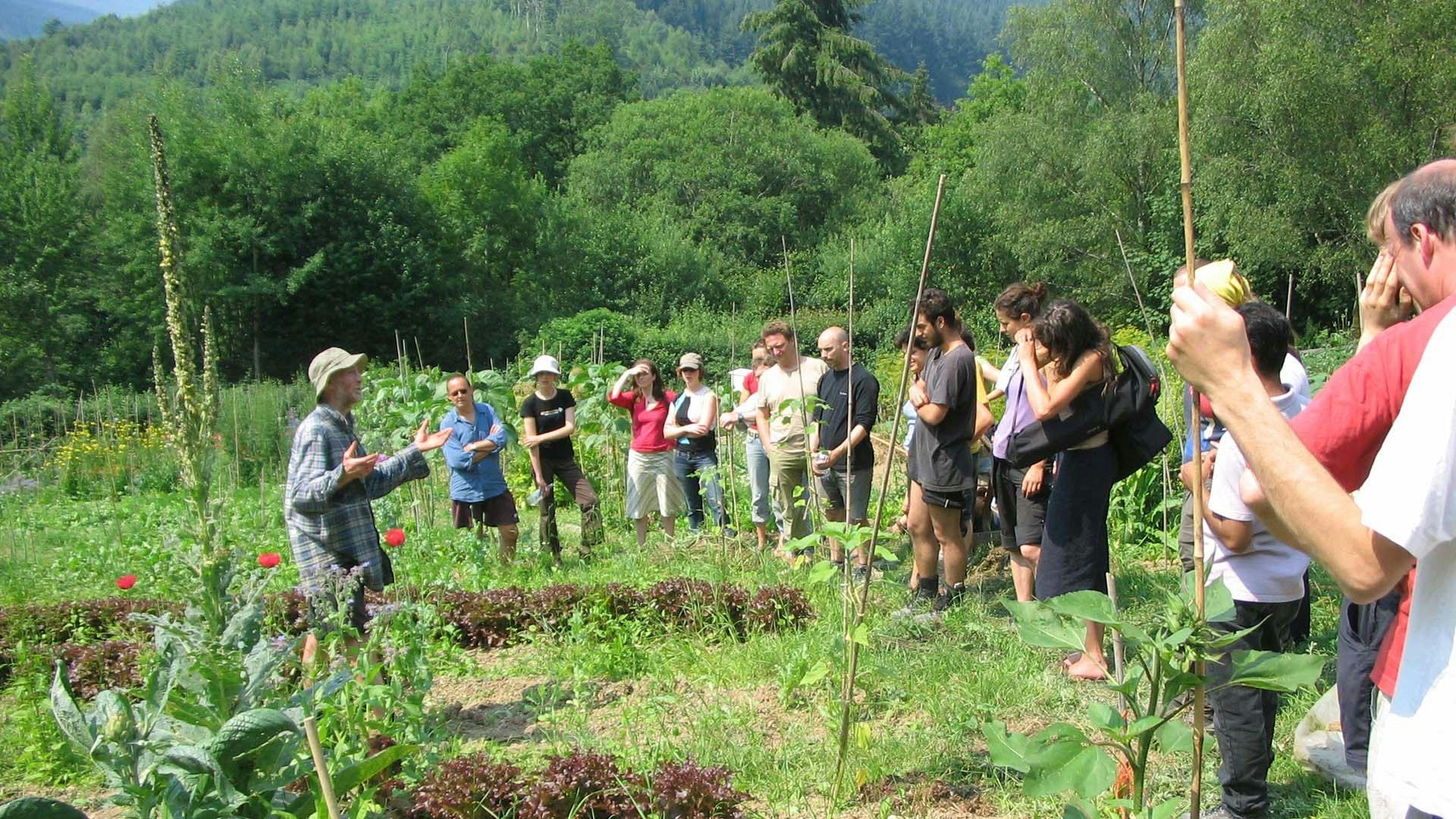
Growing Year-Round
Traditionally, summer is salad season, and root vegetables are the main winter crop. However, with a little planning you can extend the growing season and plant for harvests of fresh vegetables year-round. The key elements are successive sowings, protecting plants to allow for longer ‘seasons’, and effective storage of harvested crops.
Written for CAT by Fiona Rowe
Succession planting
It’s common practice to sow some crops in two or more batches to ensure ongoing harvests. For example – spring onions, then maincrop onions. You can go further with more frequent successive sowings. Sow lettuce in May to be ready in July, then sow in June to harvest in August, and so on. This method can be applied to most vegetables: see the plan below for a guide to sowing and planting times.
Thinnings from crops also provide a tasty, often overlooked, salad ingredient – a mini-crop of young, tender leaves. Although it can be quite labour-intensive, if you have the time it’s worth sowing thickly, then progressively harvesting your thinnings. This creates space for individual plants as they need it.
Cut & come again
Some varieties of plant have been specially developed to provide ‘cut & come again’ crops. As the phrase suggests, leaves are cut from the living plant, which then grows more leaves. Either cut the whole plant down to about 4cm above ground level, or take individual leaves, preferably from the outer part of the plant, and leave the rest of the plant to grow.
Special cut & come again seed mixes are available. Try Misticanza (lettuce, endive, chicory) and Saladini (oriental greens and mustard leaves). In fact, this method can be used on many plants (most brassicas, spinach, and lettuce, for example), even though the seed packet may not advertise it.
A variation of this technique, which works with most cabbage and lettuce, is to allow the plant to ‘heart up’, then carefully slice through the stem close to the base, just above the lowest outer leaves, leaving them in place. The plant usually regrows from this point – the heart will be less compact, but still provides good eating.

Catch cropping
You may find that an area, even if just a corner of a bed, is left empty between main crops. If so, it’s worth considering a fast-growing ‘catch crop’ – usually of salad plants. Examples like lettuce, cress, mustard, or salad rocket can be harvested when the main crop is planted or sown. Using cut & come again varieties makes this a particularly flexible use of ground. An area that would have been idle instead provides a continual harvest until you need the space.
Intercropping
This means maximising ground yield by growing two or more crops with different growth rates in the same bed. Fast-growing crops such as lettuce and radish are sown between rows of slower plants: shallots, leeks, and parsnips, for example. The quick crop is ready to harvest just at the point when the slower crop needs more room to grow.
One good combination is maincrop shallots with small lettuces, pak choi, corn salad or spring onions. Another is maincrop winter brassicas with carrots, small summer cabbages, oriental greens, kohl rabi or beetroot.
Most vegetables can be intercropped – it’s just a question of harvesting the quicker crop at the right time. Vegetables conventionally eaten when mature are usually delicious when eaten younger – consider carrots, turnips and parsnips as your quick crop.
Tall plants and climbers also provide shelter and growing space for intercropping. Plant fast-growers between rows of sweetcorn or salsify, or under pea or bean frames. All of the quick crops mentioned above are suitable for growing with French, dwarf and runner beans, and red chicory is particularly shade-tolerant.
It’s wise to plant your maincrop vegetable in rows slightly wider apart than usual. This ensures that both crops have access to sun, moisture and root-growing space. Keep your soil well fed with compost, too, as more dense planting means an increased demand for nutrition.

Extending the season
To extend the growing season – to provide plants with more growing days – we need to fool them into thinking that they live in a warmer, more hospitable climate! To achieve this, cloches, cold frames, greenhouses and polytunnels are all effective. They keep warm air and soil around plants, and therefore protect them from frost, wind and rain damage. Your choice of crop protection will depend on the space and funds you have available.
If a greenhouse is out of the question, it’s valuable to have some kind of frame to allow earlier sowing. Simple cold frames can be built relatively cheaply using scrap glass and wood. By protecting your crops, you can add up to three weeks to the beginning and end of the growing season. A very cheap way to enable earlier germination is to cover the sown ground with a sheet of clear plastic. Remove the sheet as soon as the seedlings appear.
Winter-hardy varieties offer another option. Try leeks, broad beans, purple broccoli, celeriac, oriental radishes and mustards, Welsh onion, celery leaf, Swiss chard, and winter purslane. You can also extend the season by expanding on the traditional uses of plants. Turnip leaf is edible, and overwintered broccoli, parsley, and spinach produce tasty leaves and tips the following spring. Corn salad is extremely hardy and a late sowing will provide pickings right through to the following spring.
Try non-traditional plants, too: there are numerous varieties of Japanese greens on the market, like Green In Snow and Mizuna. Some plants thought of as weeds actually make tasty salad plants – such as freely available bittercress and chickweed.
Storing your crops
There are various ways of storing vegetables, including freezing, drying and pickling. However, the easiest and most energy-efficient ways to store roots and tubers are root cellars and sandboxes. With both methods, the aim is to keep the vegetables as cool, dark, and dry as possible. The other key factor is to maintain a constant temperature – around 5°C is ideal.
You could therefore set up a root cellar if you have a room or outhouse that can provide those conditions. Store the vegetables on shelves (preferably slatted) and take them as needed. This method is particularly suitable for winter cabbages, celeriac, onions, marrows, squash and pumpkins. You can store potatoes, onions and carrots in sacks in a root cellar. Check regularly for any dampness or decay, and for signs of mice or rats.
Sandboxes are probably the best way to store roots and tubers, and ideal for carrots, potatoes, radishes and beets. They are simply boxes (usually wooden) filled with dry sand, peat or fine sawdust. You store the vegetables in this material, then fish them out as required.
You can easily store garlic and onions even without a root cellar or sandbox. Dry them on racks or slatted shelves, knot or plait the shoots, then hang them in bunches.

Planting for continual harvest
The planting guide below gives sowing suggestions for a typical growing year-round system. In practice, conditions will vary according to the region and the weather. Sowing and harvesting times will therefore overlap from month to month. This condensed plan can only cover the basic species, so be adventurous. Explore seed catalogues and garden centres for different varieties, and keep a note of what works for your particular garden.
January
- Plant: garlic, shallots.
- Sow under glass: onions, celeriac.
- Harvest: winter cabbages, Brussels sprouts and other brassicas.
February
- Plant: Jerusalem artichokes.
- Sow out: early peas, broad beans, spinach.
- Sow under glass: lettuce, carrots, radish, turnips.
- Harvest: winter cabbages, cauliflowers, Brussels sprouts and leeks.
March
- Plant: onion sets, early potatoes.
- Sow out: cabbages, Brussels sprouts, kale, turnips, leeks, onions, parsnips.
- Sow under glass: celery, celeriac, tomatoes, aubergines, peppers.
- Harvest: winter crops as above, plus spring cabbage, kale and sprouting broccoli.
April
- Plant: potatoes, globe artichokes.
- Sow out: carrots, beetroot, broccoli, kohl rabi, celeriac, radishes, salsify, calabrese, cauliflower, peas; successional sowings – Brussels sprouts, cabbages, kale, lettuce, turnips.
- Sow under glass: French and runner beans, courgettes, marrow, sweetcorn, cucumber.
- Harvest: spring greens, sprouting broccoli, turnip tops, kale, cabbage, lettuce and spinach.
May
- Plant: transplant brassicas from seed beds.
- Sow out: winter cabbages and cauliflower, sprouting broccoli, lettuce; successional sowings – lettuce, radish, turnip, beetroot, carrots, peas, parsnips, onions, spinach, Japanese brassicas, oriental saladini.
- Harvest: spring cabbage, spinach and radishes; plus from now onwards, continual thinnings to be eaten from successively sown crops – lettuce, Japanese brassicas, radishes, turnips, beetroot, carrots, parsnips, onions, and spinach; plus broad bean tops and kale tops for salads.
June
- Plant: transplant celeriac, leeks, celery, brassicas.
- Sow out: swedes, endives, parsley; successional sowings – beans, lettuce, radishes, beetroot.
- Harvest: peas, broad beans, potatoes, spinach, turnips, kohl rabi; plus successional pickings and thinnings.
July
- Sow out: successional sowings – spinach, beetroot, turnips, lettuce, carrots, kohl rabi, endives, leeks, broccoli, cabbage, Japanese brassicas.
- Harvest: broad & French beans, potatoes, shallots, carrots, turnips, beetroot, lettuce, radishes, marrows and courgettes.
August
- Sow out: winter radishes, winter lettuce, spring cabbage; successional sowings – turnips, endive, onions, corn salad.
- Harvest: as July, plus runner beans, sweetcorn, tomatoes, cucumber and garlic.
September
- Sow out: successional sowings – spinach, winter radishes and lettuce.
- Harvest: onions, tomatoes, marrows, potatoes, carrots, celeriac, spinach, runner beans and French beans.
October
- Sow out: broad beans, hardy peas.
- Harvest: potatoes, carrots, celeriac, beetroot, turnips, salsify, kohl rabi.
November
- Sow out: broad beans.
- Harvest: spinach, endive, winter cabbage, cauliflower, Brussels sprouts, celery, leeks, parsnips, Jerusalem artichokes.
December
- Plant: Traditionally, garlic was planted on the shortest day of the year – worth a try!
- Harvest: swedes, winter cabbages, Brussels sprouts, spinach, celery, leeks, parsnips, endive, kale, cauliflower and Jerusalem artichokes.
Further information
We also offer group visits and workshops, and sell many nature and growing books in our online shop.
Related events


All about bees – a family day out
24th August 2024
Beekeeping Taster Day
25th August 2024
Wild Wellbeing – Rustic bench making
9th September 2024Study at CAT: Our Postgraduate Courses


Did you know we are a Charity?
If you have found our Free Information Service useful, why not read more about ways you can support CAT, or make a donation.
Email Sign Up
Keep up to date with all the latest activities, events and online resources by signing up to our emails and following us on social media. And if you'd like to get involved and support our work, we'd love to welcome you as a CAT member.
